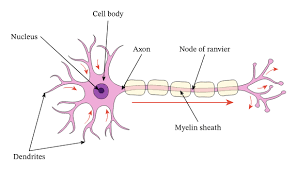Nerve signals are the invisible messengers that keep your body functioning seamlessly. From the moment you wake up to the second you fall asleep, these electrical impulses are constantly at work, ensuring your brain communicates with every part of your body. But how do nerve signals actually work? What makes them so fast and efficient? And why are they crucial for everything from lifting a finger to solving complex problems?
This comprehensive guide will dive deep into the fascinating world of nerve signals. You’ll learn how they are generated, how they travel, and how they enable you to perform even the simplest tasks. By the end, you’ll clearly understand the science behind nerve signals and their role in controlling every move and thought in your body.
What Are Nerve Signals?
Nerve signals, also known as nerve impulses or action potentials, are electrical signals that travel along neurons, the specialized cells of the nervous system. These signals allow your brain to communicate with your muscles, organs, and other tissues, enabling you to move, feel, and think.
Think of nerve signals as the body’s communication network. Just as the internet connects computers worldwide, your nervous system connects your brain to every part of your body. Without Nerve Signals, your brain would be powerless to control your actions or process sensory information.
The Anatomy of a Neuron
To understand how nerve signals work, it’s essential to first understand the structure of a neuron. Neurons are the building blocks of the nervous system, and they come in various shapes and sizes. However, all neurons share three main components:
- Cell Body (Soma): This is the core of the neuron, containing the nucleus and other organelles. It processes incoming signals and generates outgoing signals.
- Dendrites: These are branch-like structures that receive signals from other neurons. They act as the neuron’s “antenna,” picking up information from the environment or other cells.
- Axon: This is a long, thin fiber that carries nerve signals away from the cell body to other neurons, muscles, or glands. Axons can be incredibly long, stretching from your spinal cord to your toes.
At the end of the axon, you’ll find synaptic terminals, which release chemicals called neurotransmitters to pass the signal to the next neuron or target cell.
How Are Nerve Signals Generated?
Nerve signals are generated through a process called action potential. This is a rapid change in the electrical charge across the neuron’s membrane, triggered by a stimulus. Here’s how it works:
- Resting State: When a neuron is not sending a signal, it maintains a resting membrane potential of about -70 millivolts (mV). This means the inside of the neuron is negatively charged compared to the outside.
- Depolarization: When a stimulus (like touch, light, or a chemical) reaches the neuron, it causes sodium channels in the membrane to open. Sodium ions rush into the cell, making the inside more positive.
- Threshold: If the depolarization reaches a certain threshold (around -55 mV), it triggers an action potential. This is an all-or-nothing event—once the threshold is reached, the neuron will fire a signal.
- Repolarization: After the peak of the action potential, potassium channels open, allowing potassium ions to leave the cell. This restores the negative charge inside the neuron.
- Hyperpolarization: The neuron briefly becomes more negative than its resting state before returning to normal.
This entire process happens in milliseconds, allowing nerve signals to travel at incredible speeds.
How Do Nerve Signals Travel?
Once an action potential is generated, it travels down the axon like a wave. But how does it move so quickly? The answer lies in two key mechanisms:
- Saltatory Conduction: In myelinated neurons (those covered in a fatty substance called myelin), the action potential “jumps” between gaps in the myelin sheath called nodes of Ranvier. This speeds up signal transmission, allowing nerve impulses to travel at speeds of up to 120 meters per second.
- Continuous Conduction: In unmyelinated neurons, the action potential travels more slowly, moving along the entire length of the axon.
At the end of the axon, the nerve signal reaches the synaptic terminals, where it triggers the release of neurotransmitters. These chemicals cross the synapse (the gap between neurons) and bind to receptors on the next neuron, continuing the signal.
Types of Nerve Signals
Not all nerve signals are the same. Depending on their function, they can be classified into three main types:
- Sensory Signals: These carry information from your sensory organs (like your eyes, ears, and skin) to your brain. For example, when you touch a hot stove, sensory neurons send a signal to your brain, which interprets it as pain.
- Motor Signals: These travel from your brain to your muscles, enabling movement. When you decide to lift your arm, motor neurons send signals to the muscles in your arm, telling them to contract.
- Interneurons: These act as intermediaries, processing information between sensory and motor neurons. They play a crucial role in reflexes and complex brain functions like decision-making.
The Role of Nerve Signals in Reflexes
Reflexes are a great example of how nerve signals work in real time. When you accidentally touch something sharp, your body reacts instantly—before your brain even processes what happened. This is because reflex arcs bypass the brain, allowing for a faster response.
Here’s how it works:
- A sensory neuron detects the sharp object and sends a signal to the spinal cord.
- In the spinal cord, an interneuron quickly processes the information and sends a signal to a motor neuron.
- The motor neuron tells your muscles to pull your hand away.
All of this happens in a fraction of a second, thanks to the speed and efficiency of nerve signals.
Nerve Signals and the Brain
While reflexes rely on the spinal cord, most nerve signals involve the brain. Your brain is the control center of your nervous system, processing sensory information, making decisions, and sending commands to the rest of your body.
For example, when you see a ball flying toward you, your eyes send visual information to your brain. Your brain processes this information, calculates the ball’s trajectory, and sends signals to your muscles to catch it. This entire process involves millions of nerve signals working in perfect harmony.
What Happens When Nerve Signals Go Wrong?
When nerve signals are disrupted, it can lead to a wide range of neurological disorders. Some common conditions include:
- Multiple Sclerosis (MS): This autoimmune disease damages the myelin sheath, slowing down or blocking nerve signals. Symptoms include muscle weakness, fatigue, and difficulty walking.
- Epilepsy: This condition is caused by abnormal electrical activity in the brain, leading to seizures.
- Peripheral Neuropathy: Damage to peripheral nerves can cause numbness, tingling, and pain, often in the hands and feet.
- Parkinson’s Disease: This neurodegenerative disorder affects motor neurons, leading to tremors, stiffness, and difficulty moving.
Understanding how nerve signals work is crucial for developing treatments for these conditions.
How to Keep Your Nervous System Healthy
Your nervous system is incredibly resilient, but it still needs proper care to function at its best. Here are some tips to keep your nerve signals firing smoothly:
- Eat a Balanced Diet: Nutrients like omega-3 fatty acids, B vitamins, and antioxidants support nerve health.
- Exercise Regularly: Physical activity improves blood flow to the brain and promotes the growth of new neurons.
- Get Enough Sleep: Sleep is essential for brain function and nerve repair.
- Manage Stress: Chronic stress can damage neurons and disrupt nerve signals. Practice relaxation techniques like meditation or yoga.
- Avoid Toxins: Limit your exposure to alcohol, tobacco, and other substances that can harm your nervous system.
The Future of Nerve Signal Research
Scientists are constantly uncovering new insights into how nerve signals work. Advances in technology, such as brain-computer interfaces and optogenetics, are opening up exciting possibilities for treating neurological disorders and enhancing human capabilities.
For example, researchers are developing devices that can interpret nerve signals to control prosthetic limbs or even restore vision to the blind. These breakthroughs could revolutionize medicine and improve the lives of millions of people.
Conclusion
Nerve signals are the foundation of everything you do, from blinking to solving complex problems. They are the invisible force that connects your brain to your body, enabling you to interact with the world around you. By understanding how nerve signals work, you can appreciate the incredible complexity and efficiency of your nervous system.
So the next time you move your hand, feel a sensation, or think a thought, remember the millions of nerve signals working tirelessly behind the scenes. They are the unsung heroes of your body, ensuring that every move and thought is executed with precision and speed.





